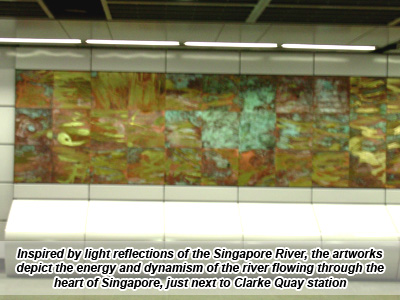|

Clarke Quay station

The curvilinear features of the entrance to the Clarke Quay station at Eu Tong
Sen Street allude to a meandering river. It is only
natural that the river is the central
theme in the station's architecture as it is located on the banks of the Singapore River.
As the North East Line runs
under the Singapore River at Clarke Quay, construction of Clarke Quay tunnels required the use of
precise methods and the latest
technology to reduce the risk of flooding and to preserve the scenic riverfront environment.
The last 20 years have seen the transformation of the riverfront into a leisure and
entertainment belt. Clarke Quay station
undoubtedly adds more like and colour to
this area since the river and its attractions are only a train ride away.
Back To Top
As bold as the brushstroke, as fluid as Chinese ink - at Clarke Quay, Chua Ek Kay celebrates the parallels between life on
Singapore River and the myriad
possibilities of his life's work in Chinese brush.
Chua Ek Kay's work for Clarke Quay is outstanding on many levels - it is as dramatic, timeless and grand as it is restful,
refined
and quiet.
A 60-metre long mural within the concourse paid area of the station depicts life on the Singapore River, through a series of four
paintings. Originally painted in ink on
rice paper, the images were then silk-screened onto vitreous
enamel panels at a factory in the United Kingdom.

Back To Top
The works in the ticket concourse area are all done on brass. His 20-metre long panel, aptly titled "The Reflections" is a
splendid
play of textures and colours in
movement. The rich swirls of gold, red, blue and green on the brass seem to race with the currents, rise and fall with the tide,
even go murky with the debris to
match the river in its many moods.

In modern day Singapore, seafaring symbols have been reprised to help commuters find
their way. Placed in pairs, the tongkang
eye tiles lead passengers into the
station, inviting them to pause at major decision-making points such as ticket vending machines or fare gates.
Back To Top
In the station, the role of Singapore River as the city's lifeline is depicted through wall murals showing the arrival of early
migrants in the 19th century; the tongkangs
that used to ply the river and finally, street celebrations by the riverside.
The nostalgia of Chua Ek Kay's silk-screened murals contrast with the raw energy of his
work in brass. Full of movement, the
dancing brush strokes seems to throb
with the life of the river and the "reflections of moving passengers".
Just as the river seems to change colour with the monsoon rains and the time of the day,
the colours of Ek Kay's brass work
seem to mirror the rhythms of nature;
the dominant red giving way to a striking green before re-emerging with traces of gold on aquamarine.
The works open up a wider space for imagination because his works on brass are more
abstract. The colours, movement and
rhythm of the painting seem to be
changing, firing the imagination of commuters.
Ek Kay applied brushstrokes on the brass sheets before immersing each of the tiles in a
chemical bath, creating an etched effect
on the acid-tinged areas. This
process also aged the acid-etched patches, changing the colours from turquoise to green to orange to dark brown.
Back To Top

The entire process of realising the artworks took a year. Four to five times a week, the
artist spent whole days at his studios,
doing his best work between 10pm and
3am.
So strong was the sense of shared vision between the artist and architect of the station
that the architect took the unusual step of
getting the station's colour scheme
changed from beige to grey to better project Ek Kay's work in black ink and on brass.
Looking back over the project, Chua Ek Kay observes that perhaps creating public art is
itself its own reward. His works at Clarke
Quay are some of the largest
works of his entire career, and yet another step in his natural course of development.
Artist:
Chua Ek Kay
Born: China, 1947
Education:
- BFA, 1994
University of Tasmania, Australia
- MA (Hons) Visual Arts, 1995
University of Sydney, Australia
next: Dhoby Ghaut station
Back To Top
|